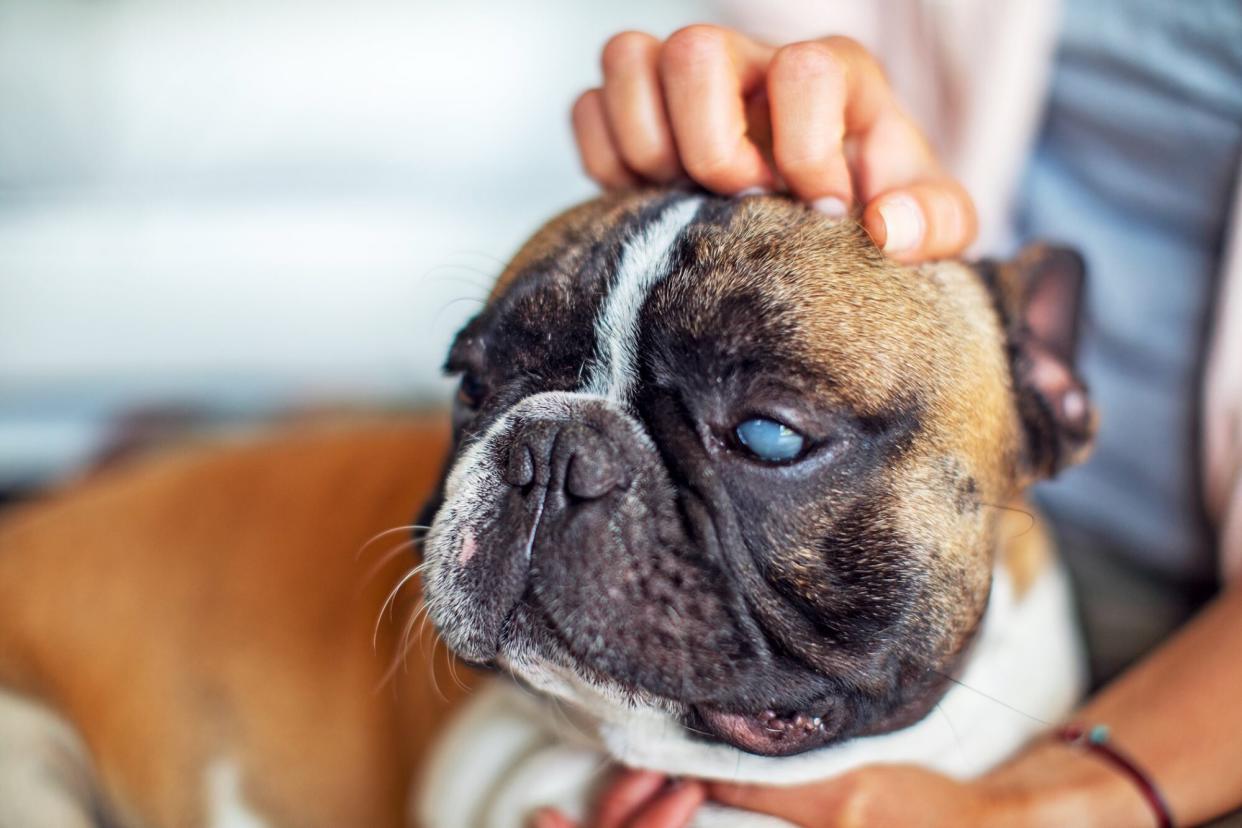Why Are My Dog's Eyes Cloudy?

JulPo / Getty
A dog's eyes are a window into the world. Whether they're hunting for a tennis ball, taking in the sights during a neighborhood walk, or playing a rousing game of fetch, dogs rely on their eyes to navigate their world.
So, cloudy eyes in dogs warrant some attention. The cloudiness may be a normal old-age change or indicate an eye problem that needs prompt, and sometimes immediate, medical attention.
Causes of Cloudy Eyes in Dogs
Let's first go over how vision works in dogs. Like human eyes, dog eyes have a lens, which is located behind the iris and has a long, sphere-like shape. The lens functions to bend light rays that enter the eye through the cornea, then focus these rays onto the retina to produce a clear, sharp image.
Cloudy eyes in dogs are often caused by problems with the lens or cornea.
Nuclear (Lenticular) Sclerosis
Nuclear sclerosis is a painless age-related eye condition that causes cloudy eyes in older dogs. The eyes have a bluish haze that is best seen from the side. With nuclear sclerosis, the lens fibers gradually harden, and dogs may have difficulty seeing things up close.
Nuclear sclerosis is often confused with cataracts. Dogs with nuclear sclerosis may end up developing cataracts.
Cataracts
Cataracts are another common cause of cloudy eyes in older dogs. They form when proteins and possibly other lens components clump and stick together. These clumps eventually block light from passing through to the retina, causing vision loss and potentially total blindness. Cataracts have various causes, including eye trauma and diabetes.
Dogs can adjust quite well to their vision loss from cataracts. However, untreated cataracts can cause severe problems such as glaucoma.
Glaucoma
Glaucoma dramatically increases intraocular pressure (pressure within the eye), causing significant pain and discomfort. It is a medical emergency and can lead to permanent damage to the optic nerve and vision loss if not treated quickly. Other than cloudy eyes, symptoms of glaucoma include a bulging eye, differently-sized pupils, and constant blinking.
Glaucoma is classified as primary (inherited) or secondary. Dog breeds that are susceptible to primary glaucoma include chow chows and basset hounds. Secondary glaucoma can be caused by cancer and untreated cataracts.
Trauma
Eye trauma can damage multiple parts of the eye, including the cornea and lens. Examples of eye trauma include eye scratches that happen during playing or fighting, damage from debris, or damage from being hit by a car.
Damage to the cornea or lens due to trauma can cause eye cloudiness.
Corneal Ulcers
The cornea is the delicate, protective outer covering of the eye. A corneal ulcer will make the eye look cloudy and cause other eye symptoms such as redness, itchiness, discharge, and excessive tearing. Ulcers are frequently painful and call for a trip to the veterinarian as soon as possible to prevent further eye damage.
Corneal ulcers have various causes, including trauma, dry eye, and viral or bacterial eye infections.
Dry Eye (Keratoconjunctivitis Sicca)
Dry eye is a painful condition that results from insufficient tear production. Tears are essential for keeping the eye lubricated. Without enough tears, the eyes become dry, itchy, and cloudy.
Anterior Uveitis
The uvea is located in the front of the eye. When the uvea becomes inflamed, the entire eye can look cloudy due to white blood cells traveling to the eye. Other signs of anterior uveitis include eye redness and excessive tearing.
Corneal Dystrophy
Ulcers aren't the only corneal problem that can cause cloudy eyes in dogs. Corneal dystrophy is an inherited condition. The cornea becomes opaque and cloudy, and the eyes may be painful. Vision loss can also occur depending which corneal layer is affected.
The type of cornea dystrophy is named according to which corneal layer is affected: epithelial (outer layer), stromal (middle layer), and endothelial (inner layer).
RELATED: 6 Strategies to Help You Properly Care for a Blind or Visually Impaired Dog
Diagnosing Cloudy Eyes in Dogs
If your dog has cloudy eyes, schedule an appointment with your veterinarian as soon as possible, especially if you notice other eye symptoms like rubbing, excessive tearing, and redness.
Your veterinarian will use various tools to closely examine your dog's eyes. An ophthalmoscope is a handheld light with special lenses that enable the vet to see different parts of the eye. A tonometer measures intraocular pressure, which would help diagnose or rule out glaucoma. Fluorescein stain is a liquid dye that adheres to ulcers and wounds on the cornea. These lesions will shine bright green when an ophthalmoscope is used in a dark room, allowing the vet to identify corneal ulcers and injuries.
If your vet cannot diagnose your dog's eye cloudiness, they may refer you to a veterinary ophthalmologist for advanced diagnostic testing.
Treating Cloudy Eyes in Dogs
The treatment for cloudy eyes in dogs depends on the underlying cause. For example, nuclear sclerosis requires no treatment, but your vet will want to continue monitoring your dog's eyes. Dry eye is typically treated with eye drops or ointments to moisten the eyes. Corneal ulcers are often treated with topical medications that fight infection and reduce pain and inflammation. Glaucoma requires immediate treatment to reduce intraocular pressure and prevent permanent optic nerve damage.
Cloudy eyes in dogs may be a normal sign of aging or indicate something more serious. If your dog's eyes start to look cloudy, take your dog to your vet for diagnosis and treatment.
RELATED: Entropion in Dogs: Causes, Symptoms, and Treatment to Give Your Pup's Irritated Eyes Some Relief

